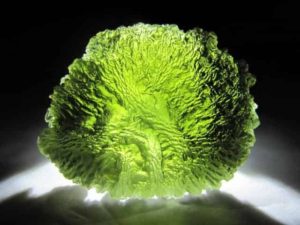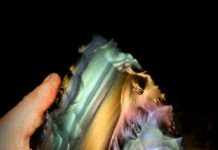
Moldavite
It is a green forest, olive green or blue green vitreous silica projectile rock formed by a meteorite impact in southern Germany (Nördlinger Ries Crater) occurring around 15 million years ago. It’s a kind of tectitis.
Crystal system: Amorphous
Color: Forest green
Luster: Vitreous
What is Moldavite Made Of?
It was believed to have been formed after a meteorite impact by condensed rock vapors. It is part of the mineral group Tektite, a small family of natural glass rocks. Moldavite is sometimes claimed to be’ the only known alien gemstone on Earth’ or’ the gemstone born from the stars.’
How Moldavite is Formed?
According to the generally accepted theory, moldavites were formed during an impact of a huge meteorite 14.75 million years ago at high pressures and temperatures from superficial tertiary sediments in the Ries area of Germany.
What is Moldavite Worth?
The value of these Moldavites jumped from about USD 5 per gram about 20 years ago to about USD 75 and even up to USD 130 per gram today. The availability is extremely low and some Asian laboratories have perfected their production to provide the market with a very good look-alike man-made “Moldovite” glass.
Moldavite Gemstone
Moldavite Color
It occurs in a variety of shades of green, including deep, forest-green and pale to olive-green. Some materials from Moravia are known to occur with greenish-brown color. The most desirable color is a pure, light to medium green with no brown, and not too dark in tone.
Moldavite Clarity and Luster
It can be opaque and transparent. The finest specimens are transparent and very rare. Today’s most moldavite is opaque with slight translucency levels. Generally speaking, the higher the transparency, the better the stone. There is a big difference in price between moldavite’ regular grade’ and museum grade.
Moldavite Cut and Shape
It comes in a variety of shapes and cuts. Only the finest and most transparent materials are faced, while the rest are usually traded in their natural rough condition. The most common shapes are those resulting from its molten formation, such as drop shape, disk shape, oval, elliptical or spiral shape, as well as shapes that resemble spilled liquid patterns. Bohemian moldavite is usually drop-shaped, while spherical is Moravian moldavite.
Where Moldavite is Found?
Moldavite’s largest deposits were found in the upper Vltava River basin between Prachatice and Trhovými Sviny, particularly in the south and west of the Czech Republic of České Budějovice (Budweis). Also found in Moravia, mainly in the Jihlava river’s central area.










